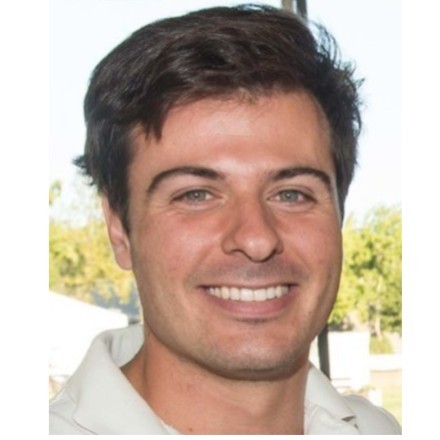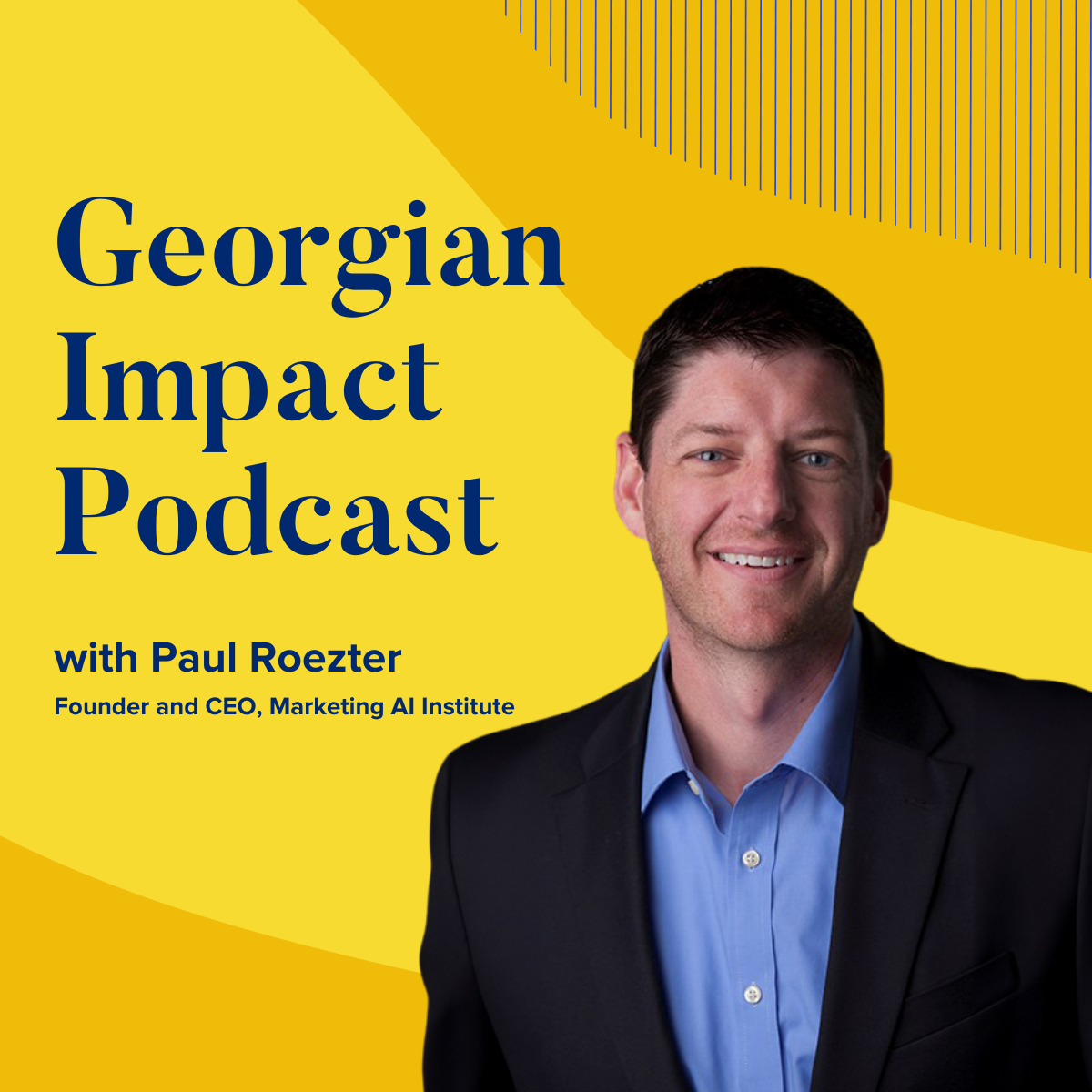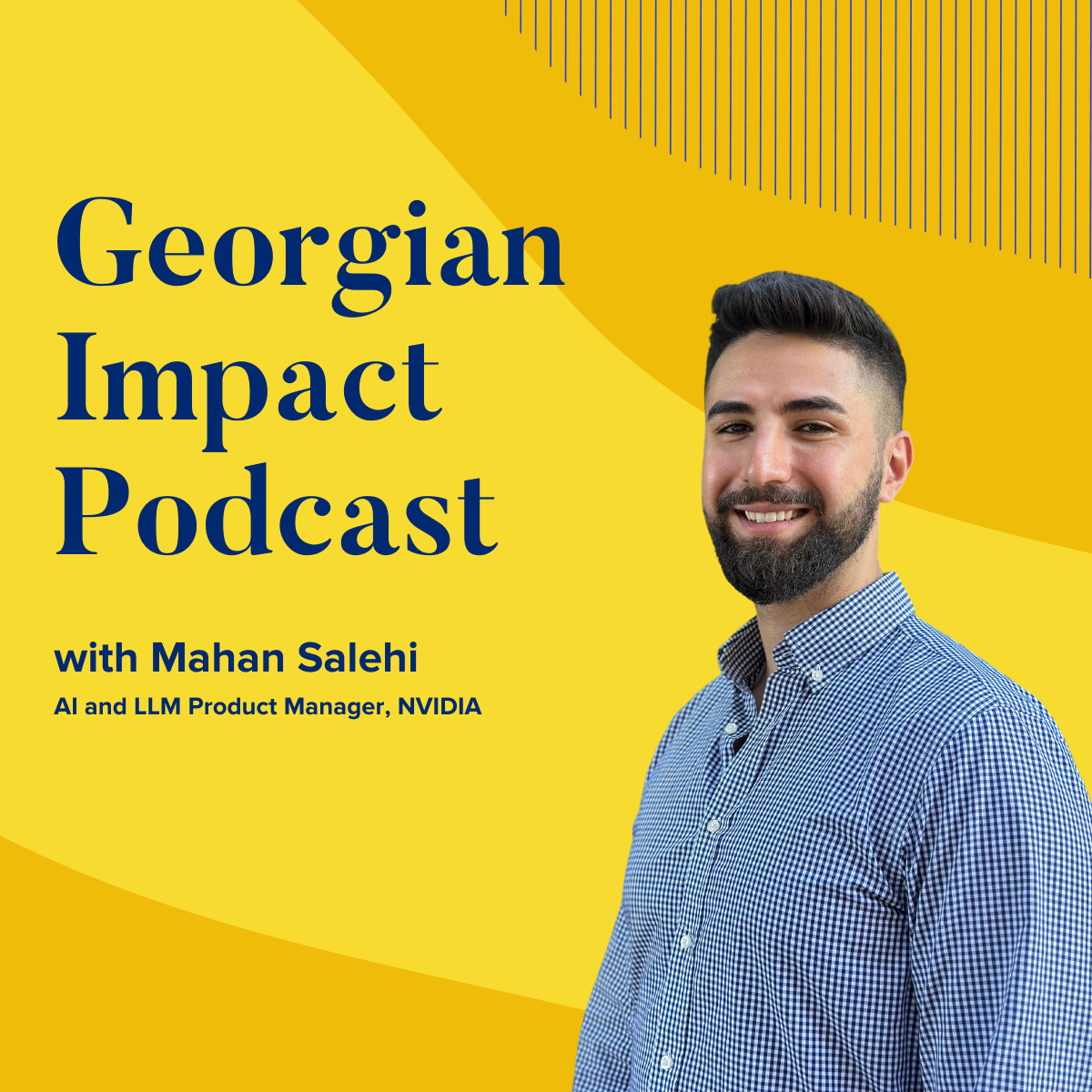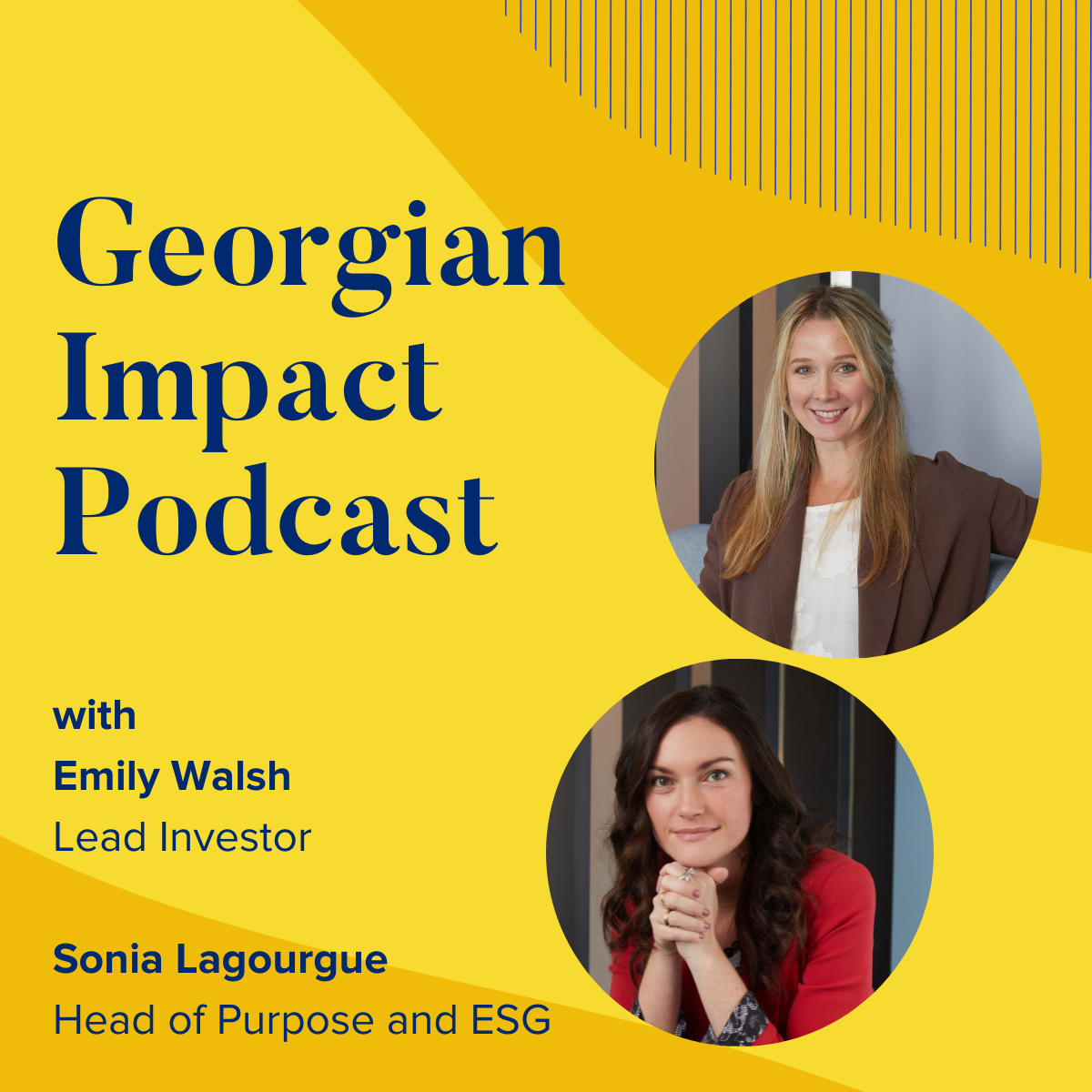How AI is Making Grocery Shopping Better
- 0.5
- 1
- 1.25
- 1.5
- 1.75
- 2
Jon Prial: Welcome to Georgian's Impact Podcast. I'm your host, Jon Prial. 2020 was a challenging pandemic year. E- commerce share of total revenue grew to 13.6% from 10.7%. Not a surprise, but I'm sure many expected that to continue. But no, in 2021, e- commerce rates dropped for the first time since 2014. Now I feel like I'm a bit in the trees because I really want to talk about the forest, and the forest is that over 85% of retail sales are still in stores. Technology opportunity, anybody? Today we'll be talking with Francois Chaubard, CEO of Focal Systems. Focal leverages AI and cameras that focus on products on shelves. Focal automates many steps in the retail and delivery supply chain and is quite an amazing story. Francois, welcome.
Francois Chaubard: Thank you very much for having me.
Jon Prial: Tell me a bit about yourself and how you got where you are.
Francois Chaubard: I come from mostly the AI side, building AI applications. And in 2014, 2015, we started to really see the applications of this step function in AI and what it could really do. Everyone was talking in Silicon Valley in 2014, if you remember, that" This is the age of automation, age of automation." And the only applications anyone was really talking about was automating cars and automating doctors. That was really it. What about everything else?
Jon Prial: So I want to start really with an overview of the retail process. Basically it's ensuring shelves are stocked and they're stocked with products customers want to buy, but there's so much more to it, right?
Francois Chaubard: Retail is one of the heaviest, most labor- intensive businesses. You look at, 13% of sales goes to labor. I think Walmart pays$ 100 billion a year in labor bill alone, it's really insane. They employ I think two and a half million people globally, I think the size of the United States Army is not even that big. And so it's huge amounts of labor. So it doesn't take a genius to realize that AI is probably going to have a key role in that business. But the incumbents, I just didn't believe, personally, were going to be able to build those applications. Zebra, NCR... NCR went public in 1880. Not 19, 18. It's going to take a long time for those folks to really grasp AI then be able to develop it. So I think that was the opportunity. So specifically the question that you asked about availability, right now it's probably the number one concern of every single major retailer, " How do I get my products on the shelf in the face of supply chain constraints, in the face of the labor availability going through the floor, wages going up and up and up?" Retention is going from on average four and a half months to two and a half months. So the turnover is insane. And so you have less experienced people that you have to pay more to and you can't find them. And so with that you're supposed to keep the shelves stocked. It's very, very difficult.
Jon Prial: I'm sure it is a challenge. So let's talk about how the technology at the heart of all this, image recognition, has developed. After investing all your work in deep learning and computer vision, how would you say this tech has evolved over the years?
Francois Chaubard: The image recognition piece is really the big advancement that happened in 2012 with the AlexNet paper. I just started at Stanford AI Lab in 2012 and that was right when the AlexNet paper hit, for those that don't know, the most important AI paper of the last 50 years. Alex Krizhevsky, Ilya Sutskever and Geoffrey Hinton out of University of Toronto, they published this paper called AlexNet, and it basically just absolutely crushed this competition that every computer vision lab competes on every single year called ImageNet. And ImageNet is roughly a thousand classes. Cat, dog, pony, stop sign, a thousand images per class. And then you train the model and you have to submit into a competition on unknown test images and see how do you do? " Here's an image. Is it a cat, dog, pony, stop sign? What is it?" And you have to guess. And at- one accuracy, I think were pre- AlexNet, 20%, 30%. At- one accuracy of AlexNet was 63%, 64%, which is just insane step function. Nowadays, at- one accuracy, meaning that if I only get one guess, do I get it right? I think we're at 91% is state of the art. And that was basically the first time that someone took massive amounts of data, deployed these neural networks on top of GPUs, used Geoffrey Hinton's 1980s paper, called Back Propagation, and let it train over days, months, to get smarter and smarter and smarter. And that opened up the floodgates on what that model can do, not just for computer vision and product recognition, which I'll get to in a second, but it opened up the floodgates, allowing for automatic speech recognition. Siri, Alexa, same exact algorithm. If you go on Google Translate right now and you use it, you're using NMT, Neural Machine Translation. That is a deep learning model with basically the same exact framework. If you watch the documentary Alpha Go, how the computer scientist beat the best Go player in the world, Lee Sedol, that's the same exact premise. There's countless, that's what Focal does really, is modeled right after that.
Jon Prial: I think about the whole retail process, and I don't know if this died or not, but I think a couple of years ago Beacon Systems were hot and it was tracking people walking around. And as I thought about it, doing research for you, I said, " It's so much more important to look at how the products end up versus how someone wanders around the store." But I'm curious what you think about Beacon Systems and why you chose to focus on products on shelves, which is what Focal does.
Francois Chaubard: Yeah. When we started the company in 2015, I knew nothing about retail. I just knew it was going to be massively automated. And I was like, "I'm going to be one of the first ones to be an expert in both AI and in retail." And I met, I think if you're in the Bay Area, I met with Richard Draeger, who runs a four- store chain out here. I bum- rushed him when he was walking around. I said, " Hey, can you teach me retail and I'll program anything you want. I'm a Stanford AI student and..." He's like, "Sure, let's do it." And he said, " It's not that difficult. You got to get products on the shelf and get customers out the door without stealing. That's it. What else you want to know?" And he was obviously being a little trite, but he was interested in, " Can the cameras do this? Can they do that?" And one of the first applications he said is, " I want to know how many customers are going down this aisle versus that aisle," and they were interested in that. And so I spent a whole bunch of time, maybe three months, getting access to their CCTV cameras, trying to track where people go. And I had spent a couple 5- hour Energy fueled nights, and the next day I had this beautiful plot and it showed me over the last six months, I had all the CCTV. I showed him the overlap, and giant red hotspot at the checkouts, giant red hotpot during lunchtime at the deli counter, blah blah blah. And big cold blue spot over center of store. And he is like, " Francois, center of store is dead. Yeah. Thanks for telling me that." I was like," Well how much would you pay for this product?" " Nothing, you didn't tell me anything new. I already knew that. You didn't know people spend a bunch of time during lunch at the deli counter? I'm in the store. I know that." So it really isn't interesting. People talk about that application. There's 20 companies, maybe 50 companies that are talking about doing that, but they never really hit real revenues.
Jon Prial: It's interesting, but not a good business process. There is a supermarket chain, I forget the name of them, Sprouts, that totally redesigned the layout that you have to walk past the crummy, boring crackers to get to the vegetables because they assume you're always walking to the vegetables. Does that still sit in your model of, " It doesn't matter."?
Francois Chaubard: It doesn't matter. No one's going to pay for that. If you go into any traditional grocery store, you walk in, they are going to put the eggs and the milk all the way in the back. Why? Because that's the thing that everyone's going to buy, the highest movement, and it makes you walk all the way to the back, walk by everything else. So you pick it up and then walk past a bunch of other stuff, more likely to go grab some stuff. And that's been as true before computer vision, before computers, I would say. But there's so many other use cases. If you're talking about... From an engineering standpoint, I look at it as, " Okay, here's the pie. Here's the$ 100 billion that Walmart spends a year. What can AI do with this?" None of that is people- counting in aisles. Why are we talking about that? The two biggest buckets of spend are spent on getting product onto shelves and getting you out the door without stealing. That's where all the money is spent. The former, robots can't do yet. We cannot get a robot to do this quickly, cost effectively, accurately. You just can't do it. We're not there yet. Checkout, self- checkouts cost$ 10,000 and depreciate over 30 years. That costs 93 cents a day or something like that. It's insane. You can't beat a self- checkout machine. That's why you see more and more self- checkouts. So we've already solved that, and good luck finding anything. Amazon Go, we put stuff on shopping carts that knew what you were throwing into the shopping cart, showed you an ad on the third thing you put in and all this gimmicky stuff. And then you look at the cost comparison and we lost hand over fist when we got compared to a self- checkout machine in terms of cost. You just can't beat it.
Jon Prial: Including the one where you've got a hand scanner, you scan it, put it in your bag to go out the door, it's 92 cents or 94 cents. It doesn't matter?.
Francois Chaubard: Those hand scanners, just rough math here, they probably cost$ 15 a pop. They probably die every year and you maybe get three transactions out of them a day, I would probably bet. So you're paying 15 bucks and how many transactions did you get of that thing? So you're paying two cents per transaction or something like that, let alone the upkeep on that stuff. The self- checkout machine does, let's say maybe 20 an hour* 20* 365, and *30 years. And it costs$ 10,000. It's zero 0. 0002 cents. That inaudible 500 times more expensive. So there's no chance, you cannot beat a self- checkout machine.
Jon Prial: With tongue firmly planted in cheek, let's get to your bread and butter. And by the way, I didn't prepare that but it just came inaudible So I want to talk about two parts. Let's talk about the shelves and stocking. So fantastic images on your website, here's... a camera looks at every shelf, you can look at these products, you can recognize the products, you can see this brand of oil, this brand of vinegar, of salad dressing, I don't remember what... The aisles are laid out. And you'll be able to quickly tell, I think you said you snap a picture every hour, so you'll be able to identify to someone in the back of the store, that they need to quickly bring out some salad dressing. Is it as simple as that? Once you've got the recognition that the labor's pretty easy, right?
Francois Chaubard: Yeah. So I think you got to break out- of- stocks into three different chunks. There's out- of- stocks that are workable, meaning that there's inventory in the back, there's out- of- stocks that are not workable, but they're orderable, so you can order more cans of coke, and there's out- of- stocks that are not workable and not orderable, and that's a supply chain issue. It's on a boat off of the coast of LA for the last three months and nothing you can do about it. So that was the most common one, is a strike at the Kellogg's factory, and there's no more cereal. So those are the three, you got to have a solution for all three. So maybe going in reverse order. If you can't order it, you can't sell air and as a grocer, as a retailer, you're only as good as what's on your shelf. So if you have nothing, you're not going to sell anything. So you got to put something there. And today there's two SOPs, Standard Operating Procedures. One, do not cover a hole with extra product because I'll lose that position and I'll never order it back, and it's gone forever, which is not good. The second one is, cover over the facings, remove the price tag. That thing is gone forever. You broke the planogram, you'll never order that thing again. And it's gone. And big no, no as well. So you're SOL. At Focal we developed this solution called adaptive planograms and that we know, one, what the most chronic outs are, so what things that constantly go out of stock so we can adjust the shelf. If Pepsi goes out of stock by 5: 00 PM every single day in this store, maybe not in another store, but this store, then maybe you should increase the number of facings. That's not the way planograms are set. They're set-
Jon Prial: You should define planogram, I think, as well.
Francois Chaubard: If you go to a grocery store aisle, imagine yourself there, close your eyes, imagine yourself in the soup section, you're going to see two facings of every single type of Progresso soup. Two facings of Italian wedding, two facings of clam chowder, blah, blah, blah. Meaning there's one next to each other. What's the probability that in every single store in America there's equal demand for Italian wedding and clam chowder and tomato bisque? No chance. So what happens very often, especially in northern New Jersey, you said you were from Fishkill, there's a lot of Italians that came into New York and then moved into the suburbs if they were so lucky, like my parents. And they really love Italian weddings soup. And so if you go to ShopRite, you're going to see exactly two facings and it's always going to be out of stock. And-
Jon Prial: Oh my goodness.
Francois Chaubard: It makes no sense. But this is what happens because they don't have sophisticated systems, and so-
Jon Prial: And even the loyalty cards... it didn't show it, because it would just say if you had X amount of Italian wedding soup, you sold X. It didn't say there was demand of Y, because you didn't do the demand. They maybe substituted.
Francois Chaubard: Well, they don't have any system to create customized planograms on a per- store basis. It's almost... I use the analogy of shirts. Everyone's a different size. Imagine I'm a T- shirt company, I can only make one size of shirt. So I make it smack dab in the middle, and I make a medium- sized shirt. I don't make a small, I don't make a large, and it's crazy. So if you go into every single ShopRite, you see exactly two facings because that's what the average is. But in one store you sell zero Italian wedding and you sell all tomato bisque and in the other one it's completely reversed. And so you're chronically out of stock, you're constantly spending labor fixing it up. It's one of the biggest reasons for out- of- stocks, actually. Is that the planograms are so ... you have this really restrictive constraint that they have to be the same, no matter if you're in northern Jersey, southern Jersey, California, whatever, it is the shelf allocation you get, and it makes no sense. So that's one of the big things.
Jon Prial: So I'm sure you have an ROI for that. So now obviously you've broken the planogram model...
Francois Chaubard: The ROI of that alone, adapted planograming results in a 3% increase in sales and a 5% increase in EBITDA.
Jon Prial: That's tremendous.
Francois Chaubard: And it's insane. No one believes that until they actually start putting it into their store. And then when you try to put it in their store, you're rewriting. It's almost like... Have you ever see the movie Moneyball? Where the guy... Billy Bean, the GM from the Red Sox is saying, " You're the first one through the wall," and the people who have their finger on the switch go nuts. And because you're rewiring the way that they do business. This is crazy to them. And if you go to a retailer, a merchant at a major retailer and say, " Hey listen, we're going to do per- store planograms," they might fall over in their chair and be like, " You're out of your mind. We'll never do that." And it's like, " But it makes so much sense." " Yeah, I know, but we just can't do it." Because they just can't. So ...
Jon Prial: Just to stay on that point then, they make money when somebody buys an end cap. So they buy some space on the end cap and they make a certain amount of money. I've just got my head wrapped around ROI. Can you say, " Well rather than take this much money for your end cap of potato chips, we're still better at putting something else because we know what sells," or is that money greater? Do you have those... I'm just really getting to the nits here.
Francois Chaubard: Oh, man. I think that trade spend is a losing proposition for these groceries, but they don't know it. And-
Jon Prial: Right. That's where I was thinking you were going to go,.
Francois Chaubard: Oh, 100%. I tell them all the time, " How do you know that you putting 10 facings of Pepsi on the sixth shelf is the right thing to do, is going to net you more sales or less sales? And how much less? Is it enough to recoup the trade spend or not?" And they don't have any idea. And so that's a huge piece that we're getting into in this adaptive planograming world. So anyway, so that's one of the sources of out- of- stocks. The next one is ordering. If you go into your local ShopRite, Stop& Shop, Kroger, Albertsons, the way that they order, largely, is they walk around with a scan gun and they shoot all the holes. Scan all the holes and lows, and then they create a list and then they go and order based on how much-
Jon Prial: Order it, because it's not in the warehouse?
Francois Chaubard: It's not in the-
Jon Prial: Not the back of the store? In other words is-
Francois Chaubard: It's not in the back of the store.
Jon Prial: It's your phase two. It's orderable but not there.
Francois Chaubard: Yeah. It should have already ordered, they have a system called CGO or Computer Generated Ordering, but it's very wrong. And I'll talk about why that is. It' so wrong. It should be really simple. " Francois, this is debits and credits. You have no cans of coke in your store, you order 100 cans of coke, you sell 50, you have 50." Why is this so hard? It's just not true. You don't have 50. The reality is that you didn't get 100, you got 80 or maybe you got zero and you actually got 100 cans of Sprite instead and someone messed up in the warehouse, happens all the time. It's called a mis- select. 3% of orders are mis- selected. Let's say that you solve that problem-
Jon Prial: You're saying there's not even that level of inventory management at the back of a store?
Francois Chaubard: Almost no one does receiving. They don't do receiving. And there's a lot of sources of product that come in. One of them is from my own warehouse. Let's say if I'm ShopRite, they have Wakefern and they'll ship product. Kroger has their own distribution centers. For outside that they use distributors like the three largest are KeHE, Unify and CNS. And so they will bring product. You'll order from them and then they'll bring it over. And then the other big one is DSD or Direct Store Delivery. Coke, Pepsi, Frito-Lay, which is over in Rockman County as well, they manage their own shelves. So they bring in product. They don't care about what your ordering system says. They just come in and they inaudible
Jon Prial: But they also have the jobbers that go on the shelves and count stuff, right?
Francois Chaubard: Exactly. Yeah.
Jon Prial: Right. Okay.
Francois Chaubard: So those are the three sources. All of that introduces error and no one is really doing-
Jon Prial: And there's no common system. Now, does Focal provide a common system? Do you manage... I love your phrase, that you talk about driving the store like you drive a car. So do you start at that end on the inbound with products coming in?
Francois Chaubard: Yep. So the first thing that you got to do if you want to automate anything, I don't care if it is a grocery store or a car, is you got to digitize the space. You got to know what the heck is going on. If I'm in a car, I would need to put cameras all around it, I would need to tell that there's a car in front of me, I would need to infer that it's coming closer to me so that I should probably stop so I don't crash into it. Similarly, in a self- driving store, you have to have cameras in the back room, you have to have cameras on the sales floor. If you're trying to order more Cheerios, if you think, " Hey, should I order more Cheerios?" and you don't know what you have on hand, how can you do it? So then what happens, and this is typical, is that they're going to order from the scan gun and they're going to go around, " Oh, I see a bunch of out- of- stocks on Cheerios." I scan it, I see my inventory management system says I have maybe zero, and I order more. But in the back room I had a whole pallet of Cheerios. They just don't know. And they do that all the time. That results in massive amounts of backroom inventory and shrink, because it eventually shrinks out. And so what Focal does is we're digitizing the entire sales floor, the entire backroom, all the end- of- aisles, the cashier stand, the produce, the fridges, everything. Every hour of every day. So I know exactly what you have and I can basically resubmit an order any time I want, the second it goes below some minimum amount that I want to make sure I always have on hand.
Jon Prial: I hadn't thought about it in terms of imaging. It's the whole discussion about Teslas have cameras versus LIDAR systems and things. But there was a point, and I know I think Walmart was pioneering, having RFIDs for at least pallets and moving to cases and things. Is that gone too, it's all replaced by imaging now. Is that where things are going?
Francois Chaubard: Yeah. It's the same exact vision. Where RFID fundamentally, from first principles, could not deliver on that, let alone economically deliver on that. So ignoring the economics for a second, I worked at Lockheed Martin for four years on the SPY- 1 B radar. Electromagnetic radiation does not penetrate through water and metal very well.
Jon Prial: Got it.
Francois Chaubard: You got a lot of water and metal in a grocery store, in a hardware store. In fashion, it works perfectly. That's why when you walk out of Macy's, it gets... now it's going to ... You got the RFID tag on there. And let's say you solve that magically somehow, I don't know. Now your biggest issue is economics. The margin of a stick of gum that costs 25 cents is let's say 10%, I don't know, 20%. So that's going to be 5 cents. An applied RFID tag costs 8 today.
Jon Prial: Okay, well so we're done with ... I'm a big fan of imaging. The other thing I would like about it is, it doesn't matter where they put the case of coke, you're going to recognize it if it's... doesn't have to go in the same place. Costcos are like that. There's always the... Above the shelf, there's stuff everywhere. It's not just... They stick it anywhere and they just know where it is, they have a more sophisticated computer system. So they know that. Can you talk a little bit about other ways that people have tried to digitize inventory management, maybe outside of imaging?
Francois Chaubard: Yeah. So there's a lot of people that have tried to digitize the space with other technology. This isn't a novel idea, I don't think I've invented the idea that hey, we should know where stuff is in the store. And so people have been at this for maybe 20 years, 30 years. So they tried weight pads, they tried light sensors, they tried drones, they tried robots and all these technologies just toppled over and didn't work. So there's a lot of ways to digitize it, to solve this ordering problem, to basically digitize the store. And so once you know, " Hey, I have two case packs of Cheerios in the back room, I have a shelf full of Cheerios, do not order more. IMS says I have zero, I don't care. Do not order more. It doesn't matter what IMS says." And the inverse, we would call that zero inventory ends, which happens all the time. It's scary. The opposite of that issue is, " IMS says I have 100, 000, and I look in the back room, I don't see any. I look on the sales floor, I don't see any. Order more." And that's what... when you start to do that kind stuff, it really starts to scare retailers. They're like, " I didn't know how bad my IMS was," because there's no truth. They have no idea how bad their inventory is. When we come in, we'll deploy our cameras and we'll override or make recommended overrides of orders and we'll show a discrepancy list to them. We've had sometimes where we have a 45%, 50% override of the orders. If they were going to order 1000 things, we told them not to order 50% of those things because the inventory's in the back room and they just didn't know.
Jon Prial: Now you talk about the term, perpetual inventory. Is that what this is? Or is that something different?
Francois Chaubard: Yep. So the next generation, there's CGO, which if you go into any shop right now, they have Computer Generated Ordering, and it works in the way I just described. Then they started to get a little fancier. And so Walmart uses perpetual inventory system. They pioneered it. They called it OSCA, On Shelf Customer Availability. And it basically goes like this, the problem that I was explaining earlier where I order 100 cans of coke... I start with zero, I order 100 cans, sell 50, I must have 50. The problem with that, let's say that you solve all the ingress issues and all of the egress issues like shrink. The thief isn't saying, " Hey, by the way, I took 20." You don't know that until later on. Breakage, all that stuff, mis- scans at the till, all causing error. But let's say you solve both those problems. Now you do have 50. Where is it? Is it in the back room? Is it in the sales floor? Is it in the customer's cart? Is it in the e- comm collections area? Is it in return? Is it in the end- of- aisle? Is it in... All you're trying to know is, answer the question, is Coke available in the soda aisle? It can't do it. So even if you still have all these things that you can't solve, then you still don't know. And so then OSCA came out with this idea of, " Well, you know what? If it's in the back room and it's not selling, then I probably am out of stock on the sales floor." And that's the logic. But this is why it doesn't work. And there's just a leaked memo from Walmart on Business Insider about how bad these systems are and how much... basically there's a bunch of Walmarts that are turning the system off because it's over- ordering so much. The reason why this doesn't work is because the median movement of a UPC in a Walmart Home Depot lows is zero a day. So grab a product at a grocery store and look at its movement, very likely over half the time it sells zero a day, maybe two a week. Now I tell you it didn't sell today. Are you out of stock or just didn't sell? So then you have to wait and you have to wait a second day, third day, fourth day, fifth day, sixth day, seventh day to get to statistical significance for you to make the order. And then so they wait a week. And then they're going to make... " You know what? We looked at the T- stat tables, we're at 90% confidence interval, we'll order." Cool. So not only did you just wait a week of being potentially out of stock, you also mis- ordered 10% of the time, because if you've had 90% confidence interval, statistically 10% of the time you're going to mis- order and you're going to result in a huge amount of back- stock, and that accumulates every single day. So it's crazy that this actual assist is the best that they got. Once you have our cameras, we know within 30 minutes that the thing is out of stock, versus a week. So that's a significant speed- up. And the accuracy is not 90%, it's 99%. And then the cool thing about the cameras is we're taking an image every hour. So it allows you to do that, which is great.
Jon Prial: So couple places I want to go. I was going to talk a little about reconfiguring stores, but it doesn't matter. People are going to walk down all the aisles. We talked about that earlier. I think we could just... You don't see that as an ROI or an end result of using your technology.
Francois Chaubard: No, I think if you look at the economics and buyer behavior, I think if you permuted all the aisles, I think you'd piss people off for about three months and then they'd forget about it.
Jon Prial: Got it.
Francois Chaubard: I think there's a lot of store lay out people that would disagree with that. Obviously you want a pretty- looking store, but I would hard press them, I'm a scientist, " Prove that." You'd have to actually prove that to me.
Jon Prial: The other one then, I want to go down the route, and this may not be for supermarkets, it may be more for department stories, but there's an interesting integration for stores that have a very strong brick and mortar physical presence with e- commerce.
Francois Chaubard: So this is one of the three, what we call retail myths that we hear about all the time, is that, " We don't need grocery stores anymore. Online shopping plus these dark stores is all you need." And in 2015 when we tried to fundraise initially, I pitched some of the most well known venture capitalists in Silicon Valley and it was remarkably hard. Over half of them told me the following, " Why are you trying to automate brick and mortar retail? There won't be any grocery stores in the US in the next five years. We'll just have dark stores and autonomous delivery drones or buggies or self- driving cars. It'll drop off to your front door in 10 minutes." And this misconception is still common today. I have to really show people the economics of why that's so, so wrong. And it's just completely in the face of every single data point that you can possibly find. The first piece there is exactly like you said. Let's say 85% of all e- com orders are fulfilled in a traditional grocery store and going up, not going down, going up. And the reason why is because Amazon used to fulfill Amazon Fresh from a dark store. They switched, they bought Whole Foods. The biggest e- com player in the world bought a brick and mortar retail and then put all fulfillment inside the Whole Foods, so it's now in the Whole Foods. Kroger. com, Safeway.com, ShopRite from home, Instacart, DoorDash, Uber Eats are all going into... they're not doing the dark store model, while DoorDash I think has three of them. They're all picking from a traditional grocery store. And the reason why is because they don't have to pay for rent. They don't have to pay for any of that. You got to have a node in the graph anywhere, and so it's either going to be a dark store or light store. What's the-
Jon Prial: Just paying for a picker.
Francois Chaubard: Yeah. What's the node in the graph going to be? Okay, fine. We'll go through a thought experiment. Let's say right now you're the CEO of 1000 dark stores across America right now, and you make, let's call it$ 100 billion a year right now. And business is great. People order, they come in, you have some pickers, and you're paying rent for these stores. You got to pay the electricity bill, you got to pay the lease, you got these people that are picking for them, putting it in cars and people are driving off. Kroger, you look at their 10, 000, there is$ 130 billion a year that you're not getting because some people don't want that. They want to walk into the store. For whatever reason, we don't need to hypothesize about... want to smell their mangoes or whatever it is. Whatever it is. I don't know and I don't care. But they have the choice and they're choosing$ 130 billion to go to Kroger right now. That's, I think, their revenue last year. Why would you not open up your doors to go get that customer too? You're already paying the lease. It's not any more lease. You only need more square footage. You might need more stocking because you're going to have so much more volume. Oh no, you have more sales, what a conundrum. Are you kidding me? So basically this thought experiment concludes with, the right answer is a light store, is what we say, an automated brick and mortar store with an e- commerce option. That's the model that Amazon has now decided, which is the leader in e- com. They definitely know more about dark stores than maybe anyone, because they have fulfillment centers. This is the model that Walmart now has converted to. And basically everyone is pushing towards that model, and I think that's the right model.
Jon Prial: Let's talk a bit more about ordering online and having this human being pick your order from the store before shipping it to you. Is this something that Focal addresses?
Francois Chaubard: One of the biggest issues in e- com right now is substitution rate. So if you're Kroger, 25% of your order will get substituted out on average. That's industry average. That-
Jon Prial: Meaning I make the decision that I don't want French's mustard, I want Gulden's mustard? When you say substituted out, is that what you mean?
Francois Chaubard: That you buy a hundred products on Kroger. com or Safeway. com or Instacart, and of those 100 products, 25 will not show up. 25, maybe half of them will get substituted out. You get refunded the other half. Leads to a huge disappointment. And the reason why-
Jon Prial: Substituted, oh, not by me, by the picker. So I order on Safeway. com, I order 100 items and you're saying 25 of those items are not the ones I ordered. They grab something else off the shelf?
Francois Chaubard: They'll text you and they'll say, " Hey, that's not here. What else do you want?" And they'll say, " Here's your other options." Sometimes they might up- level you. So that's a common thing. This is actually a big issue right now in e- com. Let's say that I ordered French's Mustard and I ordered 12 ounce. There's no 12 ounce, but there's 24 ounce and so I will put 24 ounce and I will charge you for it. Are you kidding me? I said this to a retailer and they almost threw me out of the room, but I think it's really true. The analog equivalent of this is imagine you went into a grocery store and you bought 100 products. You're pushing your cart to your car and you're stocking it and you're putting it into the trunk. Cashier runs out after you, takes 25 out, puts it back into the cart, brings it back into the store, comes back out with 25 other products that you didn't want, and then gives it back to you and then gives you a bill for it for the difference. Are you kidding me? This is happening in every single e- com transaction that's happening today, it's crazy. And Focal, we have the solution for it.
Jon Prial: This should be something that will just go away because you'll be able to know that you need the 12 ounces of mustard and it'll be there, and you'll solve these problems very quickly, I would think, right?
Francois Chaubard: Yeah. We have the cameras, so we know exactly what... Before you buy it, before you hit buy and pay for it with your credit card on Instacart, on DoorDash, on whatever, we know that they cannot fulfill it in this store. Maybe they'll divert the picker to a different store so that they can fulfill it. And if they can't even then, then maybe before you even click submit, they say, " Hey listen, we just checked the store within 30 seconds, we checked all the Focal's cameras, these are the eight products that we can't deliver. Do you want to sub out? Do you want to try something else?" right then and there before you buy it, rather than after you buy it, which maybe could be three days later, it could be an hour later, which is really inconvenient.
Jon Prial: Fracois, fantastic discussion. I learned so much. I really appreciate you giving us the time.
Francois Chaubard: Thank you so much. I appreciate it.
DESCRIPTION
In 2021, e-commerce sales dropped for the first time since 2014. With 85% of retail sales still in stores, optimizing the in-person shopping experience is a huge opportunity.
In this episode of the Georgian Impact podcast, we’re talking to Francois Chaubard, CEO of Focal Systems. Focal Systems leverages AI and cameras to automate many steps in the retail delivery supply chain.
You’ll Hear About:
● Francois’s background
● An overview of the retail process
● Self-checkout and other innovations in retail
● Beacon systems and their limitations
● How Focal AI handles out-of-stock items
● ROI from adaptive planogramming
● Focal’s process for setting up automation
● Perpetual inventory systems and what that means
● The future for brick-and-mortar retail spaces
● The value in loyalty cards.
Today's Host
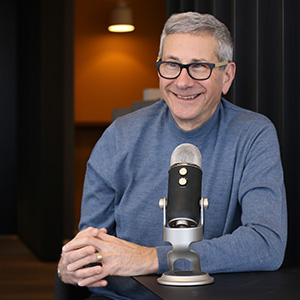
Jon Prial

Jessica Galang
Today's Guests
